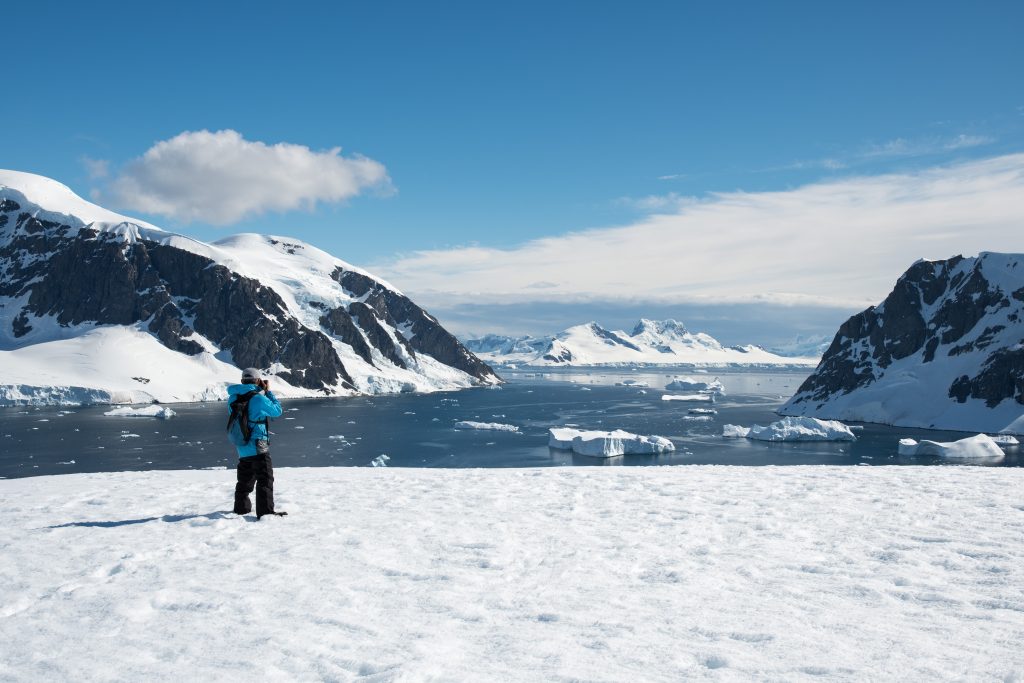Voyage Overview
As you voyage to the Falklands and South Georgia, see penguins, seals, and dolphins.
A cruise to the Falkland Islands, South Georgia & the Antarctic Peninsula. Visit some of the most beautiful arrays of wildlife on Earth. This journey will introduce you to at least 6 species of penguin and a whole lot of Antarctic fur seals!
Trip Details
Duration: 21 Days
Ship: Ortelius, Expedition Ship, 108 passengers
Start at: Puerto Madryn, Argentina
End at: Ushuaia, Argentina
Highlights:
- Add Highlights?
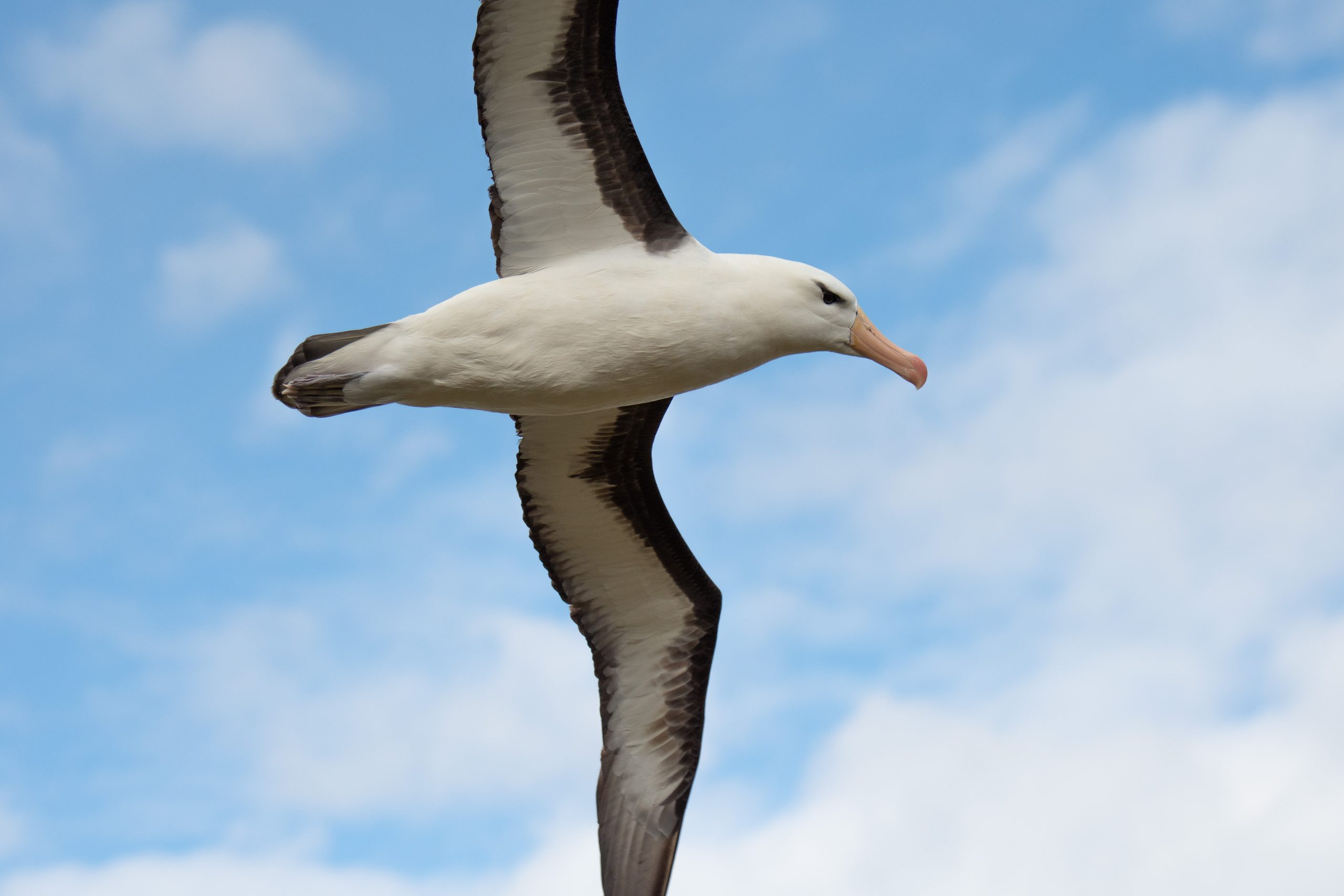
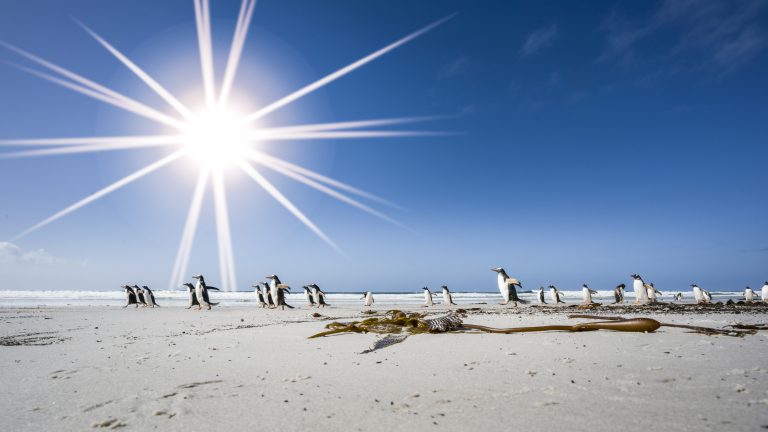
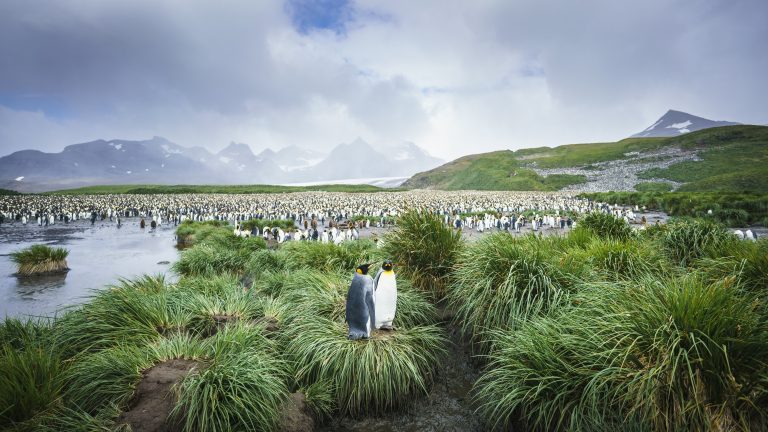
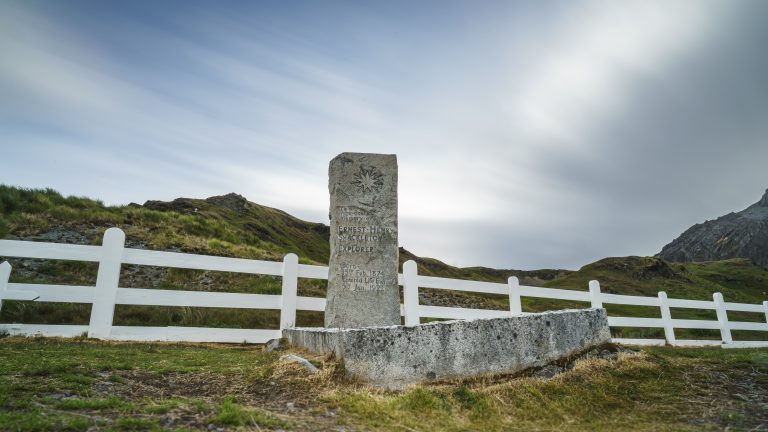
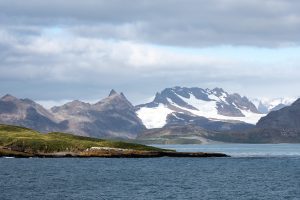
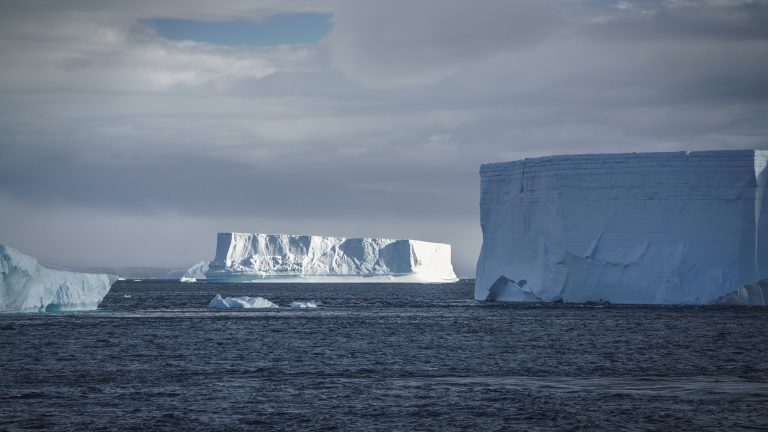
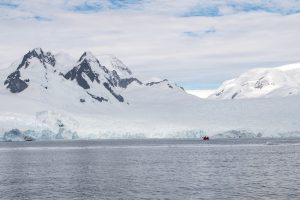
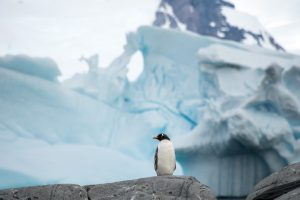
Tour Dates
Itinerary
Day 1: Embarkation from Puerto Madryn, Argentina
You embark from Puerto Madryn in the afternoon, your prow aimed for the Falkland Islands. Golfo Nuevo is renowned for its visiting southern right whales, so you have a good chance of spotting one as you sail toward the open ocean.
Day 2-3: At Sea
Though you’re now at sea, there’s rarely a lonesome moment here. Several species of bird follow the vessel southeast, such as albatrosses, storm petrels, shearwaters, and diving petrels.
Days 4: Falklands
The Falkland Islands offer an abundance of wildlife that is easily approachable, though caution is always advised. These islands are largely unknown gems, the site of a 1982 war between the UK and Argentina. Not only do various species of bird live here, but chances are great you’ll see both Peale’s dolphins and Commerson’s dolphins in the surrounding waters. During this segment of the voyage, you may visit the following sites:
Steeple Jason – Home to the world’s largest black-browed albatross colony (roughly 113,000), Steeple Jason is a wild and rarely visited island buffeted by wind and waves. Weather and swell conditions dictate the journey here.
Carcass Island – Despite its name, this island is pleasantly rodent-free and hence bounteous with birdlife and many endemic species. Anything from breeding Magellanic penguins and gentoos to numerous waders and passerine birds (including Cobb’s wrens and tussock-birds) live here.
Saunders Island – On Saunders Island you can see the black-browed albatross and its sometimes-clumsy landings, along with breeding imperial shags and rockhopper penguins. King penguins, Magellanic penguins, and gentoos are also found here.
Day 5: Stanley, Falklands
The capital of the Falklands and center of its culture, Port Stanley has some Victorian-era charm: colorful houses, well-tended gardens, and English-style pubs are all to be found here. You can also see several century-old clipper ships nearby, silent witnesses to the hardships of 19th century sailors. The small but interesting museum is also worth a visit, covering the early days of settlement up to the Falklands War. Approximately 2,100 people live in Port Stanley. Admission to the museum is included.
Day 6 – 7: At Sea
En route to South Georgia, you now cross the Antarctic Convergence. The temperature cools considerably within the space of a few hours, and nutritious water rises to the surface of the sea due to colliding water columns. This phenomenon attracts a multitude of seabirds near the ship, including several species of albatross, shearwaters, petrels, prions, and skuas.
Day 8 – 11: South Georgia
Today you arrive at the first South Georgia activity site. Please keep in mind that weather conditions in this area can be challenging, largely dictating the program. Sites you might visit include:
Salisbury Plain, St. Andrews Bay, Gold Harbour– These sites not only house the three largest king penguin colonies in South Georgia, they’re also three of the world’s largest breeding beaches for southern elephant seals. Only during this time of year do they peak in their breeding cycle. Watch the four-ton bulls keep a constant vigil (and occasionally fight) over territories where dozens of females have just given birth or are about to deliver. You can also see a substantial number of Antarctic fur seals here during the breeding season (December – January).
Fortuna Bay– A beautiful outwash plain from Fortuna Glacier is home to a large number of king penguins and seals. Here you may also have the chance to follow the final leg of Shackleton’s route to the abandoned whaling village of Stromness. This path cuts across the mountain pass beyond Shackleton’s Waterfall, and as the terrain is partly swampy, be prepared to cross a few small streams.
Grytviken – In this abandoned whaling station, king penguins walk the streets and elephant seals lie around like they own the place – because they basically do. Here you might be able to see the South Georgia Museum as well as Shackleton’s grave.
In the afternoon of day 11 and depending on the conditions, we will start sailing southwards in the direction of the South Orkney Islands.
Day 12: At Sea
There may be sea ice on this route, and at the edge of the ice some south polar skuas and snow petrels could join the other seabirds trailing the vessel south.
Day 13: The Scenic Vistas of South Orkney
Depending on the conditions, you might visit Orcadas Base, an Argentine scientific station on Laurie Island in the South Orkney archipelago. The personnel here will happily show you their facility, where you can enjoy expansive views of the surrounding glaciers. If a visit isn’t possible, you may instead land at Signy Island’s Shingle Cove.
Day 14-15: Entering the Antarctic
Enormous icebergs and a fair chance of fin whale sightings ensure there’s never a dull moment on this last sea voyage south. Also, your best chance to spot Antarctic petrels is here. Depending on conditions, we aim to begin activities the afternoon of day 15.
Day 16-18: Awe-Inspiring Antarctica
If the ice conditions permit, you now sail into the Weddell Sea. Here colossal tabular icebergs herald your arrival to the eastern side of the Antarctic Peninsula. Paulet Island, with its large population of Adélie penguins, is a possible stop. You might also visit Brown Bluff, located in the ice-clogged Antarctic Sound, where you could get the chance to set foot on the Antarctic Continent itself.
If conditions aren’t favorable to enter the Weddell Sea from the east, the ship will set course for Elephant Island and head into the Bransfield Strait, between the South Shetland Island’s and the Antarctic Peninsula. The volcanic islands of the South Shetlands are windswept and often cloaked in mist, but they nonetheless offer many subtle pleasures. A wide variety of flora (mosses, lichens, flowering grasses) and fauna (gentoo penguins, chinstrap penguins, southern giant petrels) live here.
On Half Moon Island, Chinstrap penguins and Weddell seals often haul out onto the beach near Cámara Base, an Argentine scientific research station. On Deception Island, the ship plunges through Neptune’s Bellows and into the flooded caldera. Here you can find an abandoned whaling station, and thousands of cape petrels. A number of kelp gulls, brown skuas, south polar skuas, and Antarctic terns can be spotted too. Wilson’s storm petrels and black-bellied storm petrels also nest in the ruins of the whaling station in Whalers Bay. As an alternative, you can take part in activities near Telefon Bay, further inside the caldera.
This extended voyage gives you the chance to sail even farther down the icy coast of the western Antarctic Peninsula. There are several opportunities for great landings where you might set foot on the Antarctic Continent, surrounded by an epic landscape of alpine peaks and mammoth glaciers calving at sea level. Gentoo penguins, leopard seals, Weddell seals, humpback whales, and minke whales are often seen here. The breathtaking scenery continues in the Bransfield Straight and, if conditions allow further South in the Gerlache Strait. Conditions on the Drake Passage determine the exact time of departure.
Day 19-20: Drake Passage
Your return voyage is far from lonely. While crossing the Drake, you’re again greeted by the vast array of seabirds remembered from the passage south. But they seem a little more familiar to you now, and you to them.
Day 21: Disembarkation in Ushuaia
You arrive and disembark in Ushuaia, commonly held to be the world’s most southern city. It is located on the Tierra del Fuego archipelago, nicknamed the “End of the World.” But despite this stopping point, the wealth of memories you’ve made on your Antarctic expedition will travel with you wherever your next adventure lies.
PLEASE NOTE: All itineraries are for guidance only. Programs may vary depending on ice, weather, and wildlife conditions. Landings are subject to site availabilities, permissions, and environmental concerns per IAATO regulations. Official sailing plans and landing slots are scheduled with IAATO prior to the start of the season, but the expedition leader determines the final plan. Flexibility is paramount for expedition cruises. The average cruising speed for our vessel is 10.5 knots.

Trips & Rates
Please note, rates are Per Person in USD
Availability & prices are subject to change at anytime
Voyage Ship
Ortelius
Ortelius was built in Gdynia, Poland in 1989 and originally served as a research vessel. Later it was re-flagged and renamed after the Dutch/Flemish cartographer Abraham Ortelius (1527 – 1598), who in 1570 published the first modern world atlas. Ortelius is classed by Lloyd’s Register in London and flies the Dutch flag.
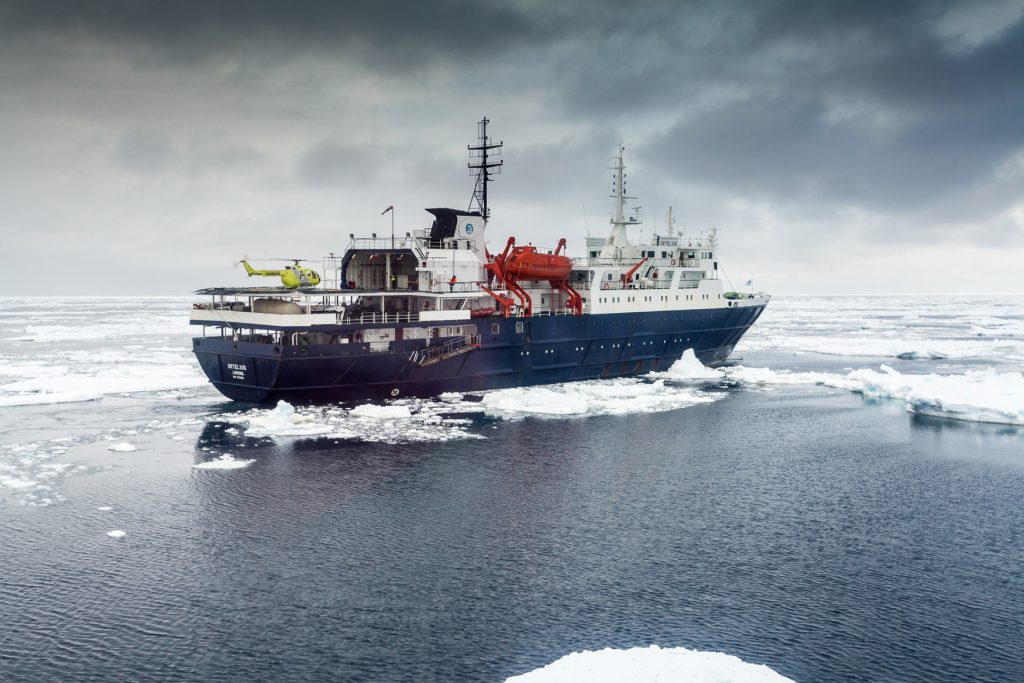
Ortelius Cabins & Deck Plan
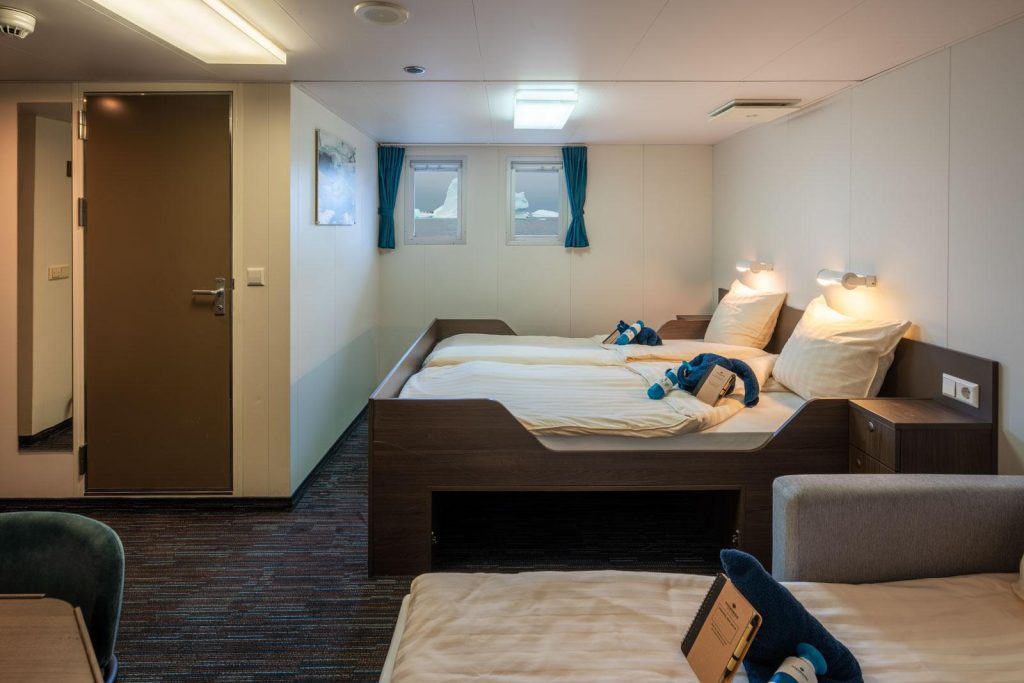
Superior
DECK 5
The 6 Superior cabins are the most spacious and the only cabin category with a double bed. They are all located on deck 5. Features: 2 windows (minimum), 1 double bed, 1 single (sofa) bed, Private shower & toilet, Desk & chair, Flatscreen TV, Telephone & WiFi (supplemented), Refrigerator, Coffee & tea maker, Hair dryer, Safe deposit box and Ample storage space.
198 – 220 sq. ft. (18.4 – 20.4m2)
1-3
1 double + single sofa bed
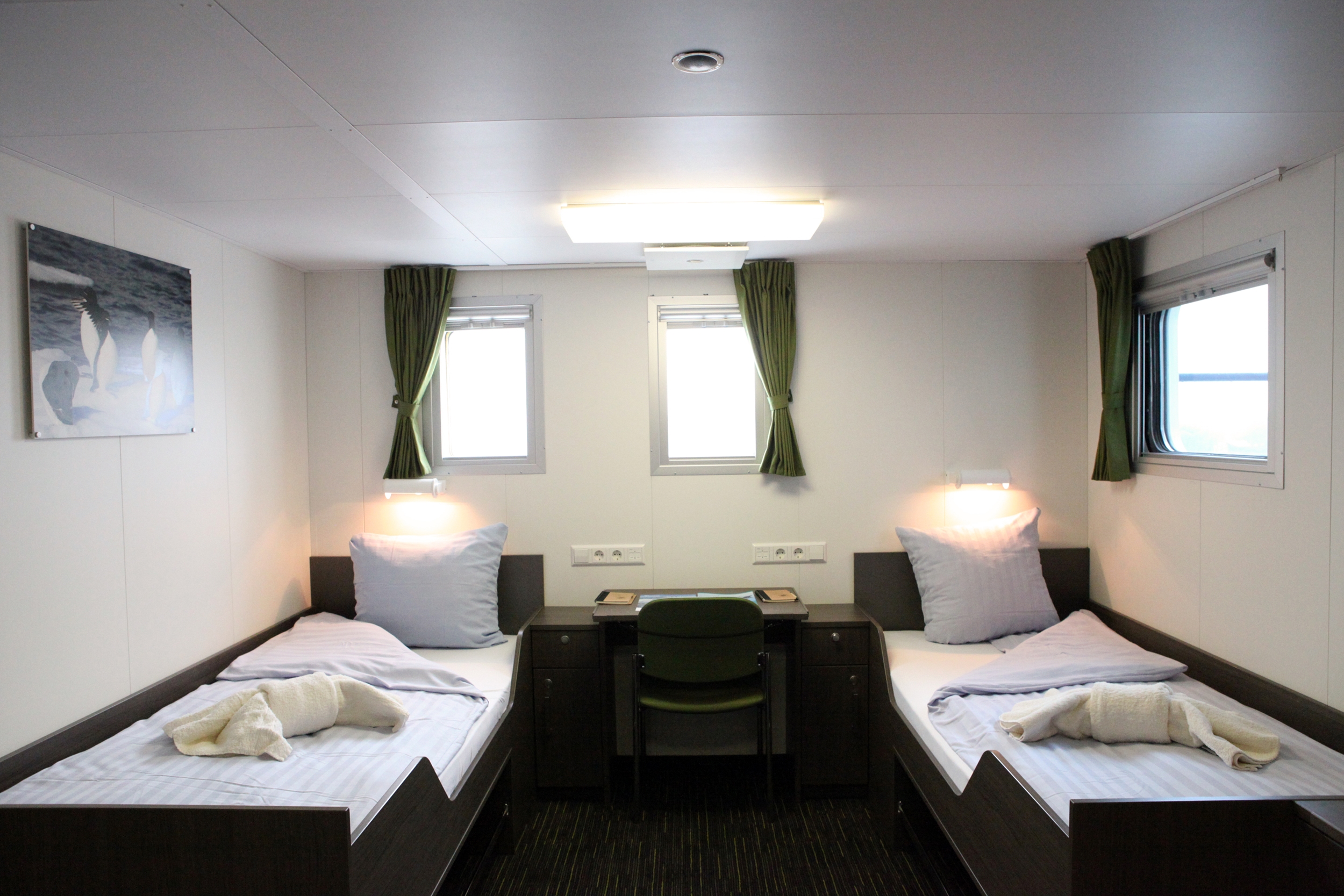
Twin Deluxe
DECK 5
There are just 2 Twin Deluxe cabins located on deck 5. Features: 3 windows, 2 lower berths, Private shower & toilet, Desk & chair, Small sofa, Refrigerator, Coffee & tea maker, Flatscreen TV, Telephone & WiFi (supplemented), Hair dryer, Safe deposit box and Ample storage space.
190 sq. ft. (17.7 m2)
1-2
2 single
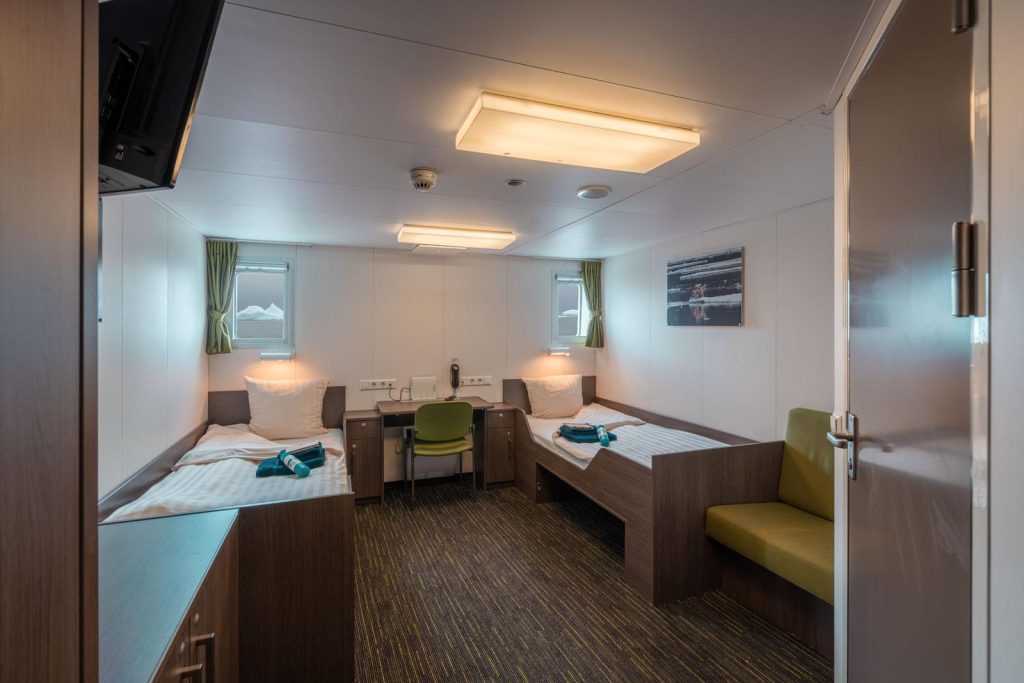
Twin Window
DECK 5
The 12 Twin Window cabins are all located on deck 5. Features: 2 windows, 2 lower berths, Private shower & toilet, Desk & chair, Flatscreen TV, Telephone & WiFi (supplemented), Hair dryer, Safe deposit box and Ample storage space.
188 – 190 sq. ft. (17.5 – 17.7 m2)
1-2
2 single
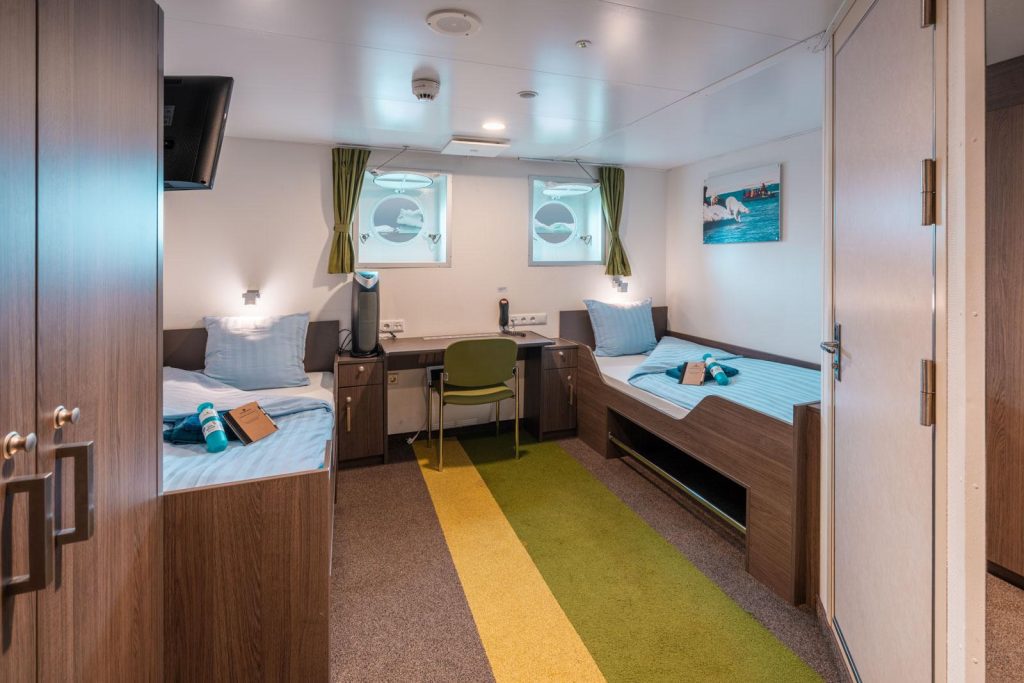
Twin Porthole
DECK 3
DECK 4
The most abundant cabin category, most of which are located on deck 4 (there are 2 on deck 3). Features: 2 portholes, 2 lower berths, Private shower & toilet, Desk & chair, Flatscreen TV, Telephone & WiFi (supplemented), Hair dryer, Safe deposit box and Ample storage space.
123 – 163 sq. ft. (11.4 – 15.1 m2)
1-2
2 single
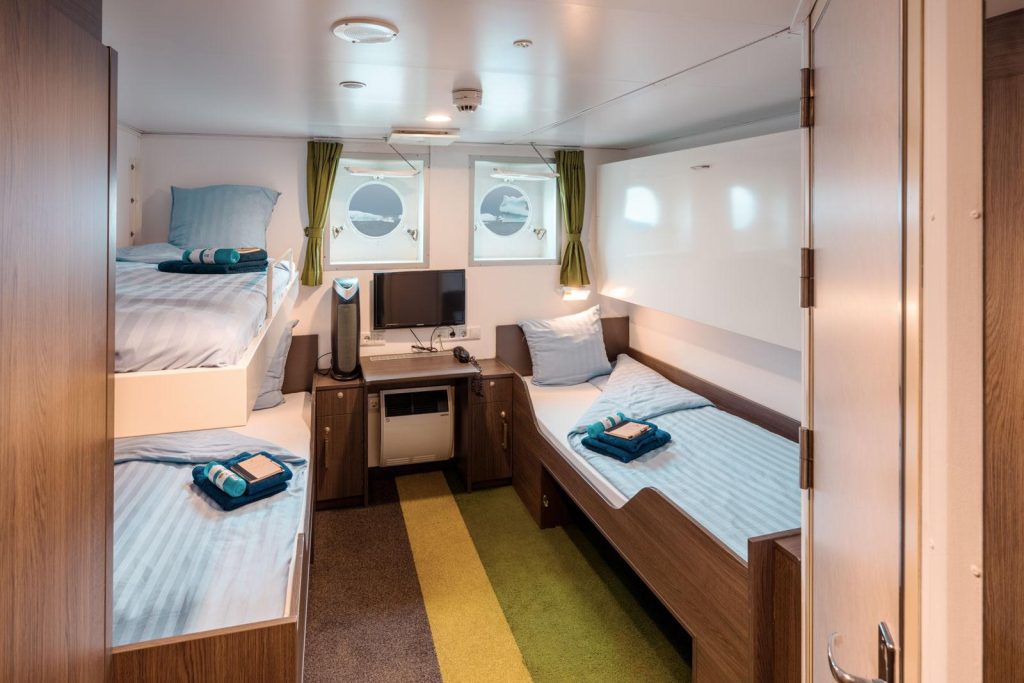
Triple Porthole
DECK 3
2 Triple cabins located forward on deck 3. Features: 2 portholes, 1 upper berth & 2 lower berths, Private shower & toilet, Desk & chair, Flatscreen TV, Telephone & WiFi (supplemented), Hair dryer, Safe deposit box and Ample storage space.
1-3
3 single
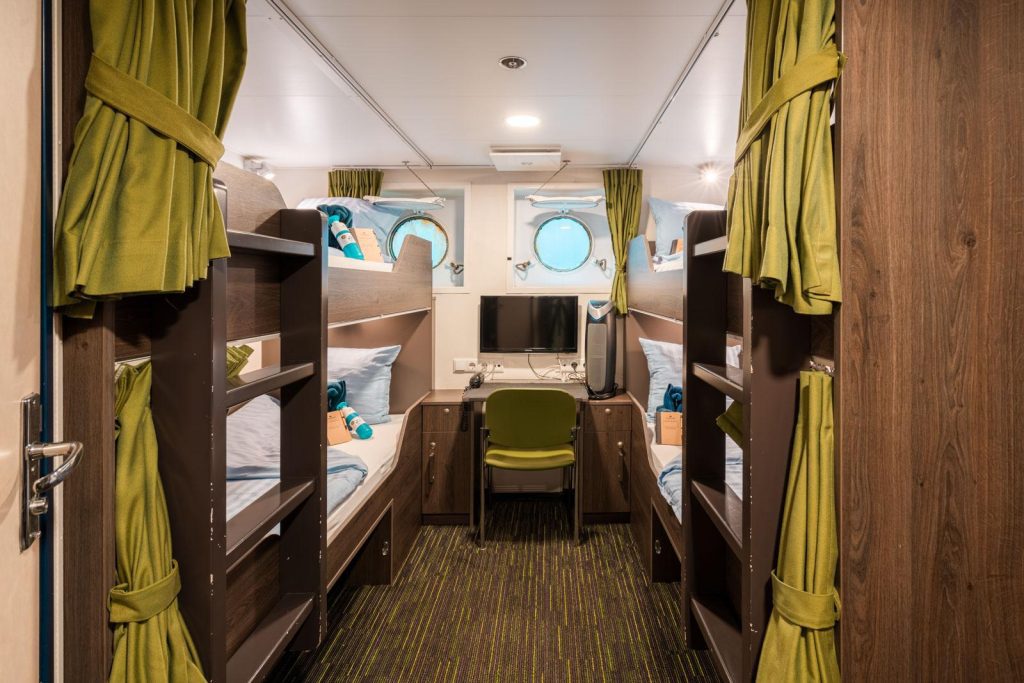
Quadruple Porthole
DECK 3
4 Quad cabins midship on deck 3. Features: 2 portholes, 2 upper berths & 2 lower berths, Private shower & toilet, Desk & chair, Flatscreen TV, Telephone & WiFi (supplemented), Hair dryer, Safe deposit box and Ample storage space.
133 – 152 sq. ft. (12.4 – 14.1 m2)
1-4
4 single
Inclusions/Exclusions
Inclusions:
- Voyage aboard the indicated vessel as indicated in the itinerary
- All meals throughout the voyage aboard the ship including snacks, coffee and tea.
- All shore excursions and activities throughout the voyage by Zodiac.
- Program of lectures by noted naturalists and leadership by experienced expedition staff.
- Free use of rubber boots and snowshoes.
- Pre-scheduled group transfer from the vessel to the airport in Ushuaia (directly after disembarkation).
- All miscellaneous service taxes and port charges throughout the programme.
- Comprehensive pre-departure material.
Exclusions:
- Any airfare, whether on scheduled or charter flights
- Pre- and post- land arrangements.
- Passport and visa expenses.
- Government arrival and departure taxes.
- Meals ashore.
- Baggage, cancellation and personal insurance (which is strongly recommended).
- Excess baggage charges and all items of a personal nature such as laundry, bar, beverage charges and telecommunication charges.
- The customary gratuity at the end of the voyages for stewards and other service personnel aboard (guidelines will be provided).
Solo Travelers
An expedition cruise to the Polar regions is a fantastic trip for solo travelers. On most ships, there is the option to share a cabin with another guest of the same gender to keep the pricing down. Solo occupancy cabins are also an option for guests who prefer to have their own space. Please reach out for more information and pricing for solo travelers.
